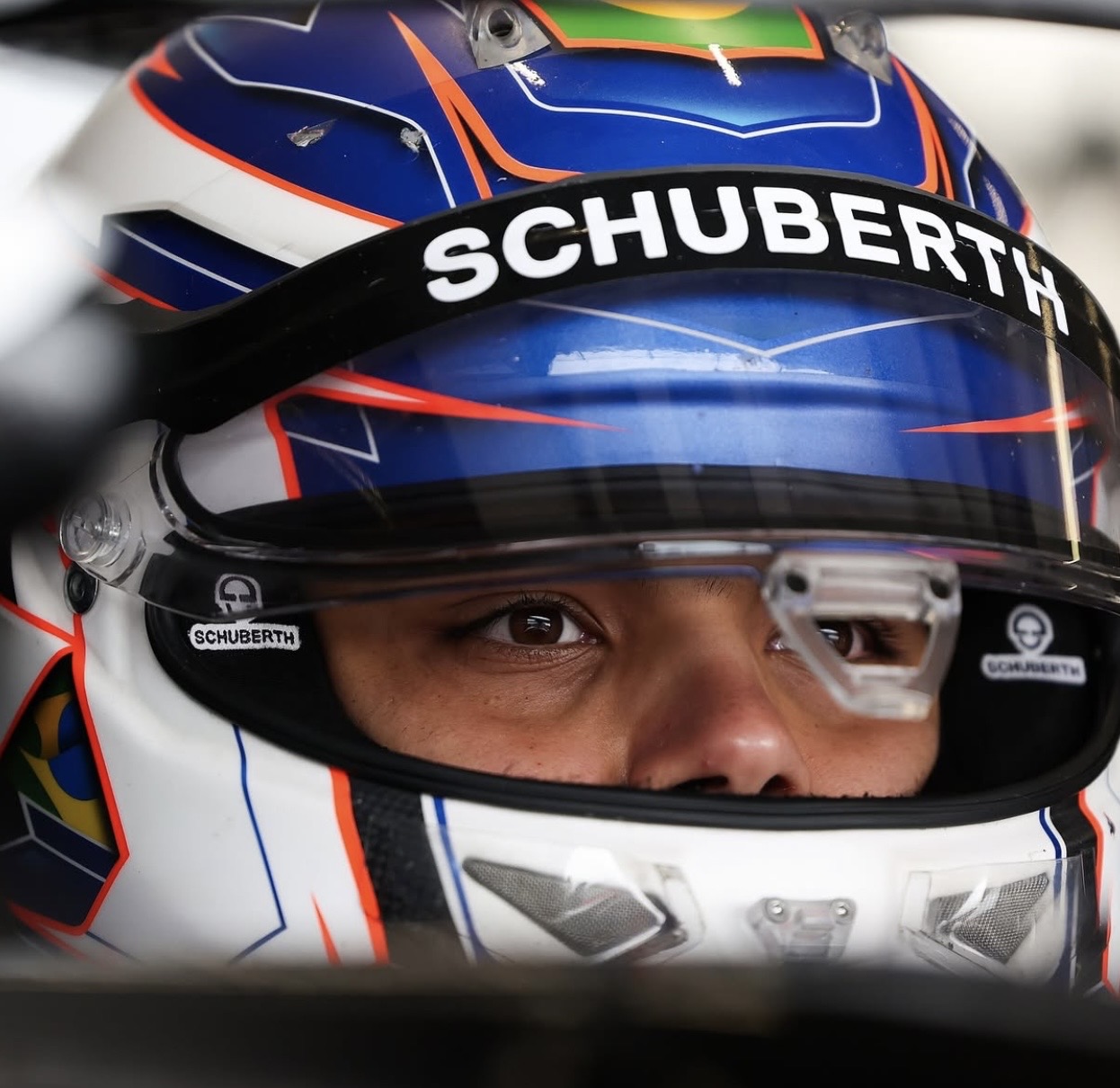Alessandro Giusti combines speed, style, and superstition through his helmet designs. The French driver, who spent the 2025 F3 season with MP Motorsport, brings two helmets each weekend and explains how colour, personal symbols, and traditions shape his look.
Colours, symbols, and personal identity
At first glance, the most striking feature of Giusti’s helmet is its vibrant colour scheme—dominated by bold blue tones.
“My new helmet is basically full of blue, because my car is blue, but blue is a colour I have liked,” Giusti explained.
The choice is not just about team alignment or aesthetics. Giusti’s connection to blue runs deep, but so does his attachment to orange, a colour he carried with him from his early karting days.
“I stayed with orange as well, that I had from go karts, it was an easy choice honestly,” he says. “Everyone in karts had blue, white and red, so I chose orange to have a difference to the others.”
The orange does not just add contrast—it serves a practical purpose. Giusti wanted to stand out, both for visibility on track and as a subtle nod to his individualism.
“To be quite specific, the change of blue—the front is quite dark compared to the back, which is quite light,” he adds, pointing to the layered gradient of shades. This play of colour creates a dynamic visual effect while distinguishing the front and rear of the helmet.
Beyond colour, Giusti adds his signature “W design” and a personalised “Sandro design” to the back of every helmet—symbols that have become a trademark of his identity.
Designer, heritage, and continuity
Giusti doesn’t create his helmets alone. He works closely with Adrien Paviot, a designer renowned for creating helmets for F1 stars like Pierre Gasly and Charles Leclerc.
“Adrien Paviot designed this helmet. He has done all my helmets since I started racing. I go to him and tell him what I want, and then he will design it,” Giusti said.
Their long-standing collaboration has allowed Giusti to evolve his design with consistency while adding layers of personal meaning. One such element is a stylised interpretation of the French flag.
“I’m French, so blue, white, and red on the helmet was good. But I changed the red to orange, to be a bit different so my dad could see me on track and a bit of white, because it’s cool.”
It is a thoughtful mix of national pride and practical design, ensuring that his helmet remains not only a symbol of where he comes from but also a functional tool on the circuit.
“The Sandro, we wanted to have something in go karts that is only on my helmet, and we found it and you can even see it on my old helmets,” he adds. This through-line of continuity connects Giusti’s karting past to his current Formula 3 career, showing that his identity as a driver has always been clear—even from the earliest days.
Superstition guides helmet choices
For Giusti, helmet design isn’t just about looks or heritage—it’s also about ritual. The French driver adheres to a personal routine that dictates which helmet he wears and when.
“Last year it was one helmet for the Saturday, because the best helmet was the one for Saturday and the other helmet for the Sundays for the races,” he explains.
This routine isn’t just habit—it’s superstition. Like many athletes, Giusti believes in preserving certain rituals, especially if they coincide with good results. Each helmet has subtle differences.
“The other helmet I have is only light blue, dark blue and white, but this new one has a bit of orange and more white, that’s pretty much it,” he says.
While both helmets are variations on a theme, the nuances in colour and design carry personal meaning. One is reserved for qualifying, the other for race day—each with its own role in Giusti’s weekend performance.
Future designs and possibilities
When it comes to future helmet designs, Giusti keeps an open mind—but also values what he already has.
“Honestly, I don’t know if I would add another design. Maybe a space shuttle one, a special one, but this year I am happy with the two helmets I have,” he says.
That openness to creativity, tempered by a satisfaction in what currently works, mirrors Giusti’s approach to racing: methodical, detail-oriented, but always leaving room for inspiration.
Giusti follows a routine with his two helmets. He explains: “Last year it was one helmet for the Saturday, because the best helmet was the one for Saturday and the other helmet for the Sundays for the races.” He distinguishes the second helmet: “The other helmet I have is only light blue, dark blue and white, but this new one has a bit of orange and more white, that’s pretty much it.”
When considering future designs, he stays cautious but open: “Honestly, I don’t know if I would add another design. Maybe a space shuttle one, a special one, but this year I am happy with the two helmets I have.”
Purpose behind the design
Every detail of Giusti’s helmet serves a purpose. He chooses orange for visibility for his father, applies the “W design” and “Sandro design” for personal identity, and trusts Stilo to deliver comfort and safety. Giusti transforms helmets from protective gear into expressions of style, superstition, and racing heritage.
Giusti’s dedication to helmet design shows that in motorsport, success isn’t just about speed on track, it’s also about identity, focus, and ritual. By blending personal symbolism, national pride, and superstition, Giusti ensures that every helmet reflects who he is as a driver and as a person. His meticulous approach to design mirrors his approach to racing: precise, thoughtful, and always looking for an edge.





